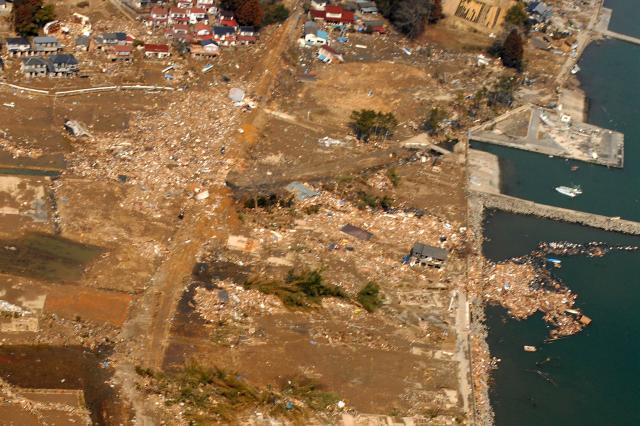U.S. military forces are working alongside their Japanese counterparts to provide aid as the country digs out in the aftermath of the massive 8.9 magnitude earthquake and tsunami that struck March 11.
“Because of the longstanding and close working relationship between the U.S. military and its Japanese counterparts on a daily basis, the United States military has humanitarian assistance capabilities positioned in the affected regions that are ready to support emergency relief efforts and minimize human suffering,” U.S. Ambassador to Japan John V. Roos said in a statement to the media yesterday.
Dubbed Operation Tomodachi, which is Japanese for “friendship,” U.S. military assets mobilizing in the area include a wide range of equipment, air, sea, and ground capability and expertise.
“We have units from all of our services, with a multitude of capabilities, from medical to communications to civil engineering, poised and ready to support where needed,” Roos said.
Yokota Air Base in Japan was instrumental in recovering airline traffic in the hours immediately following the earthquake, Roos said. Also, Yokota is being used as an alternate airfield for planes that cannot land at Tokyo’s Narita Airport. The air base is also providing food and shelter for displaced Japanese, according to reports.
U.S. Air Force and Marine helicopter and transport aircraft were moved from Okinawa to the U.S. military bases on Honshu.
Two SH-60 Seahawk helicopters from the U.S. Naval Air Facility Atsugi have already delivered 1,500 pounds of rice and bread to people in the town of Shiroishi, in one of the worst-hit parts of Japan, according to reports.
Marines and sailors from III Marine Expeditionary Force are supporting relief operations and its subordinate units are providing command and control, aviation and logistics support, according to Marine Corps officials.
The troops are capable of providing food, water, transportation and other relief support.
The proximity of aviation assets at Marine Corps Air Station Futenma in Okinawa has allowed Marines from III MEF to quickly deploy critically needed supplies and aid to areas that need it most, officials said.
“In a matter of hours supplies, gear and manpower began flowing into mainland Japan with more to follow,” said Marine Lt. Col. Karl C. Rohr, the assistant chief of staff of current operations for III MEF.
Yesterday, CH-46E Sea Knight helicopters with Marine Medium Helicopter Squadron 265, III MEF, departed Marine Corps Air Station Futenma bound for Naval Air Facility Atsugi on mainland Japan.
A squadron from Marine Corps Air Station Yuma in Arizona also has been tapped to help with the relief efforts.
The aircraft carrier USS Ronald Reagan is now off the coast of Japan’s main island of Honshu and the USS Tortuga is expected to arrive today.
According to reports, the Reagan is serving as place for Japanese helicopters to land and refuel. There are two escort ships with the Reagan and four more destroyers on the way to conduct search and rescue, according to reports.
The Tortuga is loaded with two heavy lift MH-53 Sea Stallion helicopters. The USS Essex, an amphibious ship carrying a 31st Marine Expeditionary Unit is still a couple days away.
The USS Blue Ridge, a command ship loaded with relief supplies, has left Singapore but it will get to Japan after Essex.
The U.S. Air Force’s Air Mobility Command forces are poised to support relief operations in Japan, according to AMC officials.
Numerous AMC aircraft and crews have been placed on alert, according to officials, positioning forces to take-off within hours of receiving the call to support the humanitarian relief effort.
Tanker and airlift aircraft are included in the alert posture. Forces from the 615th Contingency Response Wing at Travis Air Force Base, Calif., are poised to deploy to open and operate airfields and receive and off-load humanitarian relief supplies, according to a release.










